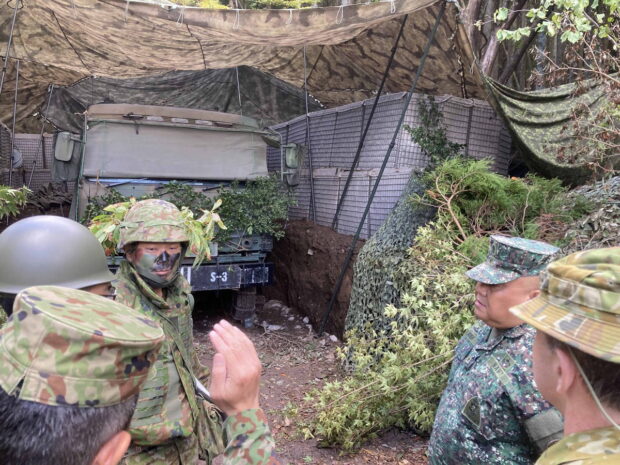PH sends observers to ‘Resolute Dragon’ drills between Japan, US

LEARNING FROM ALLIES Philippine military officials are briefed by their foreign counterparts as they observe activities related to the Japan-US military exercise “Resolute Dragon.” —PHOTO FROM JAPAN GROUND SELF DEFENSE FORCE
OITA, Japan—The Philippines has sent observers to a major military exercise between Japan and the United States here that seeks to enhance joint response between the two powers for future contingencies in the region.
Australia, another treaty ally of Washington, also sent observers to the joint drills called “Resolute Dragon,” in the latest demonstration of closer defense cooperation among the four countries amid China’s assertiveness in the East and South China Seas and around Taiwan.
The exercise from Oct. 14 to Oct. 31 involves nearly 7,000 Japanese and American troops and is being held in multiple locations, including the Yausubetsu Training Area in Hokkaido and Camp Yonaguni in Okinawa close to Taiwan, where they will rehearse and strengthen response to crises as a unified force.
The Inquirer, upon the invitation of Japan’s Ministry of Foreign Affairs, witnessed the joint training of Japanese and American troops on island defense on Sunday at Hijyudai Maneuver Area in Oita, part of Kyushu Islands where Tokyo has been beefing up its defenses for a Taiwan contingency.
This year’s iteration of the exercise is the largest and most complex so far in preparation for regional threats that may threaten Japan’s sovereignty, according to Japanese and American military officers who spoke to the Inquirer on background.
Future exercises
The Philippines’ visit contributed to the strengthening of Japan-US-Australia-Philippines relations, the Japan Ground Self Defense Force said.
The seven-member team from Manila, which visited from Oct. 19 to Oct. 21, was led by Brig. Gen. Jimmy Larida of the Philippine Marine Corps.
Joining as observers is an initial step for possible participation in future exercises, Larida told the Inquirer. His delegation also learned best practices on coordination in operations from their Japanese and American counterparts.
“Their capabilities are parallel, so it’s more about training on coordination and interoperability between them. In our case, we’re still developing our capabilities, so we’re learning from them,” he said of the visit.
Japan has been joining Philippine-US military drills in the country as an observer while also participating in trilateral exercise on disaster response.
A reciprocal access agreement between Manila and Tokyo, reportedly currently under negotiations, will allow larger exercises between the two countries in the future.
The defense ministers of the four countries agreed in June on the sidelines of a regional security summit to step up security cooperation amid shared challenges in the region.
Japan has expressed concern over China’s repeated incursions in the Senkaku Islands in the East China Sea, which is under Tokyo’s jurisdiction but which China claims as part of its territory.
In its national security strategy released last year, Japan said its security environment “faces the severest and most complicated national security environment since the end of the war,” being on the front lines of activities of Russia, North Korea, and China.
Regional powers
Akio Takahara, a professor at the University of Tokyo, said Japan’s alliance with the United States was “absolutely crucial” not only for its own security but for the region.
“Japan, after World War II, decided that we will not have a military, not go nuclear, and will not have a huge fleet that will protect our sea lines of communication,” he said.“The choice was to have an alliance with the US. They have a security cooperation and that basic policy of Japan has not changed,” the professor said.
In the face of Chinese aggression in the South China Sea, the Philippines has also sought to shore up its alliances with regional powers, especially the United States and Japan.
Earlier this month, Navy ships from the Philippines, United States, Japan, and Canada sailed together in a show of solidarity in waters off southern Luzon as part of the sea phase of “Exercise Sama-Sama” (together).
The Philippine Navy’s frigate BRP Antonio Luna, the Japan Maritime Self-Defense Force’s destroyer JS Akebono, the Royal Navy’s offshore patrol vessel HMS Spey, the US Navy’s guided-missile destroyer USS Dewey, and the Royal Canadian Navy’s HMCS Vancouver steamed in formation near the Philippine Sea as part of the joint naval exercise.
The formations signified “unity, unwavering commitment and success in performing well” to achieve the objectives of the exercise, according to the Naval Forces Southern Luzon.
Nearly 2,000 soldiers took part in the exercise from Oct. 2 to 14, which also included observers and experts from Australia, France, New Zealand, and Indonesia.